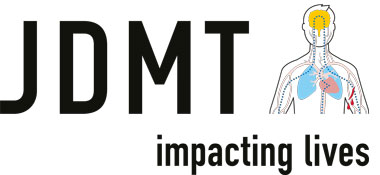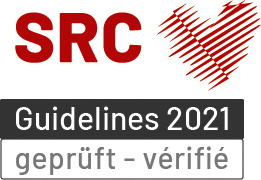Physical particularities in children
Consciousness
As children’s brains are still developing brains, fever-inducing infections will commonly lead to convulsions (febrile convulsions).
Breathing
Infants have a relatively large head and a short neck. Since their voice box is higher up than in adults, children breathe primarily through their nose, meaning the common cold more significantly inhibits breathing than in adults. For the same reasons, in order to establish effective breathing, the head should not be overextended towards the back of the neck as in adults, but must be placed in the “sniffing position”.
Oxygen requirements and therefore the normal breathing rate is 2-3 times higher in newborns, infants, and school-age children than in adults. However, their airways are much narrower. Furthermore, the mucosal surface lining their airways often overreacts by excessively swelling and producing copious amounts of mucus. Therefore, airway swelling in response to allergies, asthma, infections, irritants and foreign bodies, quickly leads to breathing difficulties. The “sniffing position” is also indicated for effective respiration in infants.
Children’s immune systems are still maturing. Therefore, common, “normal” infections can quickly lead to significant respiratory problems.
Circulatory System
Circulatory arrest in children is most often second to a respiratory problem (airway obstruction, drowning), while circulatory arrest in adults is most often second to cardiac issues (especially myocardial infarction). Therefore, artificial respiration during re-animation is much more important in children than in adults. Children have a significantly smaller blood volume than adults. Therefore, a relatively small loss of blood may lead to serious consequences for children.
The risk of internal abdominal bleeding is also more significant in children, as their internal abdominal organs are less well protected.
Skeletal System
Children have a very flexible bones. Therefore, thoracic organs can be more easily injured as the flexibility of the ribs and chest wall enables strong compression forces to enact large amounts of pressure on these organs (heart, lungs, major arteries), even without external signs of injury.
An infant’s head is relatively large in comparison to their body size. Together with a less well-developed musculoskeletal system, children are thus more at risk for cervical spinal injuries.
As a result of children’s limited ability to support and protect their head, high forces can more easily lead to brain trauma and injury (ex : whiplash, shaken baby syndrome).
Body Temperature Regulation
Compared to their body volume, children have a large body surface area. Therefore, children more quickly lose large amounts of heat, especially at their head. Furthermore, infants are especially poor at producing heat through active body movements and trembling. Children also sweat less than adults. This leaves children especially vulnerable to the cold (Hypothermia) and the heat (Heat stroke).
REMEMBER
- Consider the child as its own person, with its own personality!
- Children are especially vulnerable to airway problems!
- Circulatory arrest in children is most often caused by airway problems. Therefore, artificial respiration during re-animation of a child is crucial!
- In order to establish effective breathing in children, the head should not be extended into the back of the neck as with adults, but the head must be placed in the «sniffing position»!
- Blood volume loss in children quickly lead to significant consequences, and the situation can escalate rapidly!
- Smaller children are especially at risk for head and cervical spine injuries!
- Never shake an infant or small child!
- Children must be especially protected from the climate and weather!








